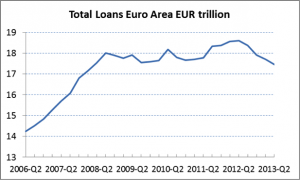Here is a typical statement regarding supply and demand: “if the demand for any product increases, given the existing supply, the price of that product will rise.” This wording gives the impression that a supply exists, as if suspended through time. In fact, supply and demand are constantly changing. They are flows, not static quantities. The supply available now is not there a moment later.
The typical statement could be interpreted as meaning that, if the demand flow had been stronger at a given moment than it was, and the supply flow had been as it was at that moment, then the price would have been higher.
Even this is misleading. It is vital to remember that we are talking about “tendencies” not equations, because human action is not deterministic but deliberative. If a stronger demand flow had met the supply flow at that given moment, what could happen? Possible conditions at the next moment are many: prices rise, supply flow increases, demand flow decreases, sellers supply ‘loyal’ buyers and phase in price rises over a period, or demand shifts to similar products of higher quality. These are all possibilities and there may be many more.
I would suggest an alternative general statement: There is a constant tendency for supply to match expected demand. During periods when demand is rising whilst supply is rising more slowly or not at all, prices tend to rise and this price rise tends to counteract the imbalance. The idea can be similarly stated for falling demand as well as rising or falling supply. Let’s not forget either, that this self-balancing tendency may be hindered if the freedom of any actual or potential sellers or buyers is restricted, for example by intimidation, regulation or other state intervention.
Changes in supply are made by entrepreneurs, who choose the quantities, qualities and prices of products that they will offer on a particular day. They have to guess what mix of these things buyers will want on that day. It is like a game of rock, paper, scissors: neither seller nor buyer know what the other will sell or buy tomorrow; both try to anticipate the other. They often use information about past behaviour to guess future behaviour. There is no continuum, but rather a series of jumps in the dark. There is rarely a static market where buyers and sellers hang around, adjusting their positions and eventually finding the right price to clear the market. If the market were static, that is what would happen, but it is not and so the market doesn’t clear exactly, except on rare occasions and by chance.
Finally, a word against graphs showing supply demand curves, which are perhaps even worse than the typical statement with which we started. These graphs suggest that there is a static set of data for supply and demand, perhaps in a computer model, where the modeller can adjust price and see supply and demand shift to clear the market. This data never exists. No-one could ever plot the curves with real data. These graphs can only mislead the student of economics.
Matt Taylor is an entrepreneur and an enthusiastic investor in UK private companies. In 2011, he founded Rockpool Investments, which has so far helped over 3,000 people invest alongside him. Inspired by Sowell’s Basic Economics, Matt is committed to spreading the ideas of freedom and spontaneous order as widely as possible.


